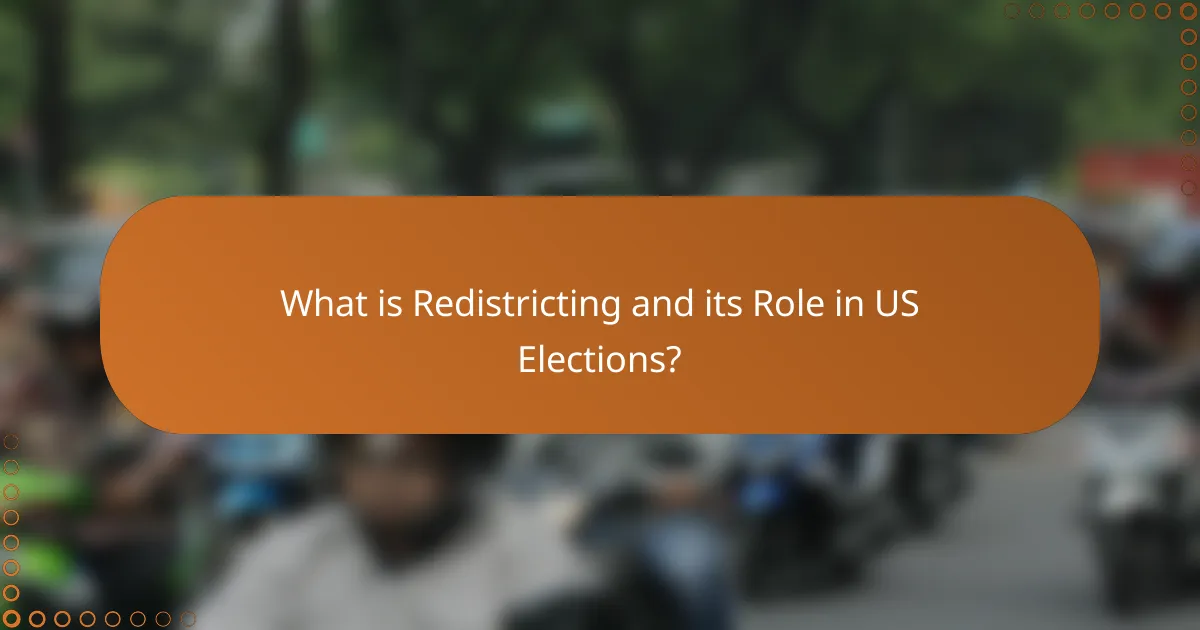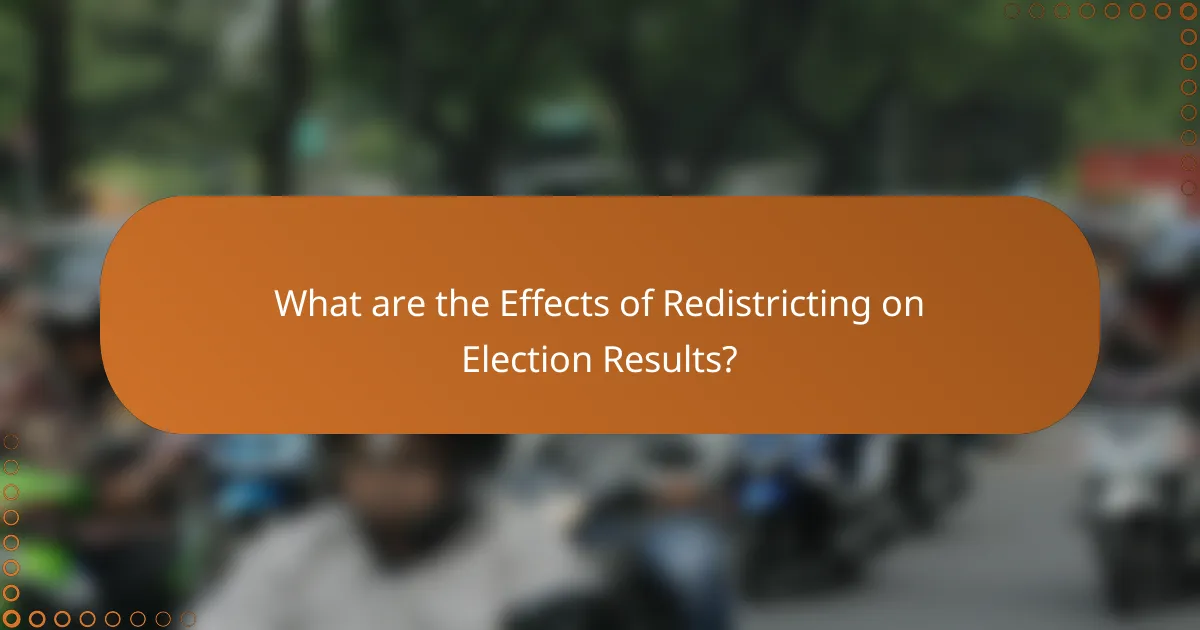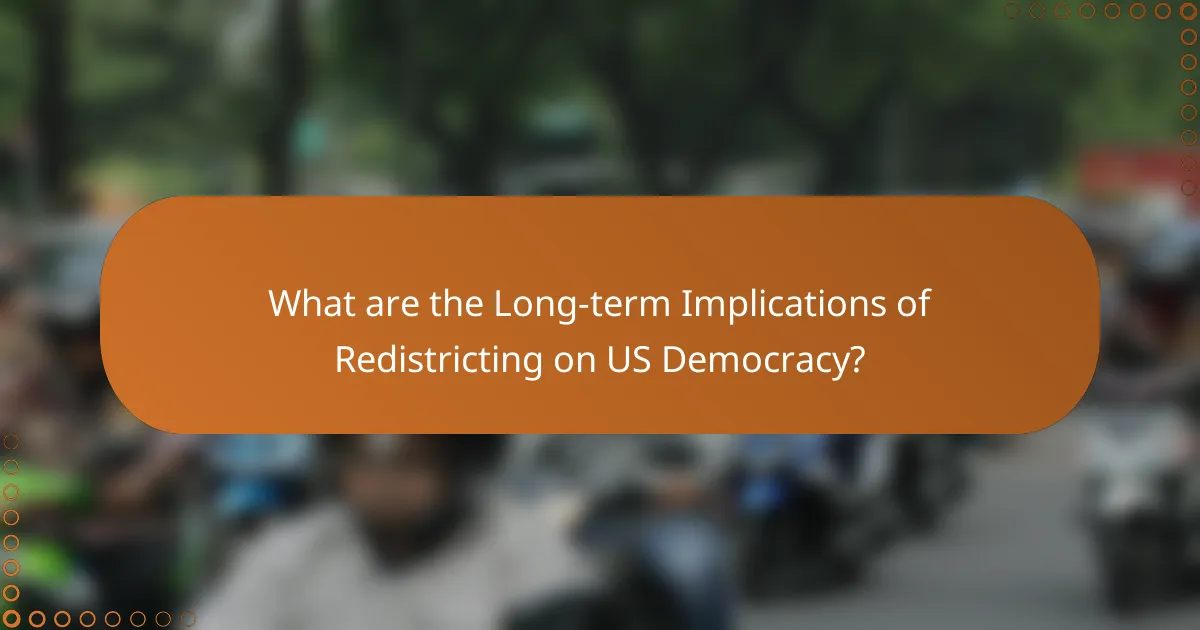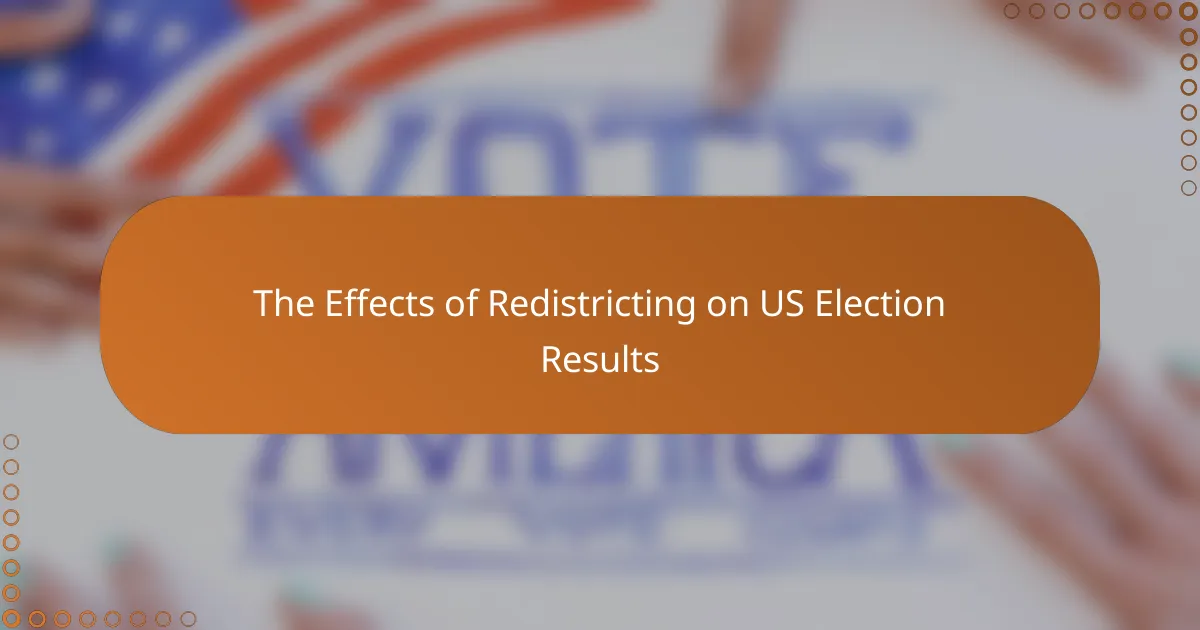Redistricting is the process of redrawing electoral district boundaries in the United States, occurring every ten years after the census. This process is vital for ensuring equal representation in Congress and state legislatures, as it can significantly affect election outcomes by determining voter demographics within districts. Gerrymandering, the manipulation of district boundaries to favor one political party, is a key concern associated with redistricting, leading to disparities in electoral competitiveness and representation. Historical examples illustrate how redistricting has influenced political power dynamics, with recent cycles demonstrating its impact on voter turnout and political polarization. The implications of redistricting extend to the overall health of US democracy, affecting citizen engagement and accountability among elected officials.

What is Redistricting and its Role in US Elections?
Redistricting is the process of redrawing electoral district boundaries. It occurs every ten years after the census in the United States. This process is essential for ensuring equal representation in Congress and state legislatures. Redistricting can significantly influence election outcomes by determining which voters are grouped together. It can create districts that favor one political party over another, a practice known as gerrymandering. Historically, redistricting has affected the balance of power in various states. For instance, the 2010 redistricting cycle led to substantial gains for the Republican Party in several states. The role of redistricting in US elections is crucial, as it shapes the political landscape and voter representation.
How does Redistricting impact electoral representation?
Redistricting impacts electoral representation by altering the boundaries of electoral districts. These changes can affect which voters are included in a district. When district lines are drawn, they can enhance or dilute the voting power of certain demographic groups. This process can lead to gerrymandering, where boundaries are manipulated to favor one political party. Historical evidence shows that redistricting can significantly shift the balance of power in legislative bodies. For example, after the 2010 census, many states experienced changes that resulted in increased Republican representation. The impact of redistricting is evident in election outcomes, as it can determine which party wins seats in Congress and state legislatures.
What are the key processes involved in Redistricting?
Redistricting involves several key processes. The primary process is the collection of population data, typically from the U.S. Census. This data determines how districts are drawn based on population shifts. Next, map drawing occurs, where state legislatures or independent commissions create new district boundaries. Public input is often solicited during this phase to address community concerns. After the maps are drawn, they undergo legal review to ensure compliance with federal and state laws. Finally, the new districts are implemented for upcoming elections. This process can significantly affect election outcomes by altering voter demographics within districts.
How do population changes influence Redistricting?
Population changes directly influence redistricting by altering the distribution of constituents within electoral districts. As populations grow or decline in specific areas, the need to redraw district boundaries arises to ensure equal representation. For instance, the U.S. Census, conducted every ten years, provides critical data on population shifts. This data informs state legislatures on how to adjust district lines. If a region experiences significant population growth, it may gain additional congressional seats. Conversely, areas with declining populations may lose representation. Redistricting aims to maintain the principle of “one person, one vote” by ensuring districts are roughly equal in population. This process can significantly impact election results by changing the political landscape and voter demographics within districts.
Why is Redistricting a contentious issue in US politics?
Redistricting is contentious in US politics due to its potential to influence electoral outcomes. It involves redrawing district boundaries, which can affect representation. Political parties often engage in gerrymandering, manipulating boundaries to gain an electoral advantage. This practice can dilute the voting power of specific demographic groups. Legal battles frequently arise over fairness and compliance with voting rights laws. According to the Brennan Center for Justice, partisan redistricting can lead to significant disparities in representation. These factors contribute to the ongoing debates about fairness and democracy in the electoral process.
What are the arguments for and against Redistricting?
Redistricting involves redrawing electoral district boundaries. Arguments for redistricting include promoting fair representation and addressing population changes. It can help ensure that districts reflect current demographics. For example, the U.S. Census data influences redistricting to represent shifts in population.
Arguments against redistricting often focus on gerrymandering. Gerrymandering manipulates district boundaries for political advantage. This can lead to uncompetitive elections and disenfranchisement of voters. Critics argue that redistricting can entrench political power rather than promote fairness. Historical examples show that gerrymandering has skewed election results in favor of certain parties.
How does Redistricting relate to political power dynamics?
Redistricting significantly influences political power dynamics by reshaping electoral boundaries. It can alter the representation of political parties within legislative bodies. When district lines are redrawn, the demographics of the electorate can change. This often leads to advantages for the party in power during the redistricting process. For example, gerrymandering can create districts that favor one party over another. Historical instances, such as the 2010 redistricting cycle, demonstrate how Republicans gained control in several states. This control can lead to long-term political advantages and influence policy decisions. Ultimately, redistricting serves as a tool for political maneuvering, impacting governance and representation.

What are the Effects of Redistricting on Election Results?
Redistricting significantly influences election results by altering electoral boundaries. It can lead to changes in voter demographics within a district. This often results in a shift in political representation. For example, districts may be drawn to favor one political party over another, a process known as gerrymandering. Studies show that gerrymandering can increase the likelihood of one party winning a majority of seats despite receiving fewer overall votes. Historical data indicates that redistricting has consistently impacted election outcomes, particularly in closely contested areas. In the 2012 elections, for instance, redistricting played a crucial role in determining control of the House of Representatives. Therefore, redistricting can create significant disparities in electoral competitiveness and representation.
How does Redistricting affect voter turnout?
Redistricting can significantly affect voter turnout by altering the demographics of electoral districts. Changes in district boundaries can create more competitive races or lead to uncompetitive ones. Competitive districts often encourage higher voter engagement and turnout. In contrast, uncompetitive districts may result in voter apathy and lower turnout.
Research indicates that states with more competitive districts experience higher turnout rates. For example, the 2018 midterm elections saw a turnout of 50% in competitive districts compared to 30% in non-competitive ones. Additionally, redistricting can influence the representation of minority groups, affecting their motivation to vote. When minority groups feel adequately represented, they are more likely to participate in elections.
Thus, redistricting plays a crucial role in shaping voter turnout dynamics across different electoral landscapes.
What factors contribute to changes in voter turnout post-Redistricting?
Changes in voter turnout post-redistricting are influenced by several factors. One factor is the alteration of district boundaries, which can affect the demographics of the electorate. New district lines may create more competitive races, motivating higher turnout. Additionally, changes in representation can lead to shifts in voter engagement. If constituents feel their new representatives are more aligned with their interests, they may be more likely to vote. Conversely, if voters feel disconnected from their new districts, turnout may decrease. Historical data shows that states with significant redistricting often experience fluctuations in turnout percentages. For example, the 2010 redistricting cycle saw varying turnout rates across states due to these factors.
How does voter engagement vary across different districts?
Voter engagement varies significantly across different districts due to factors such as demographics, socioeconomic status, and local political culture. Districts with higher socioeconomic status often see greater voter turnout. For instance, urban areas typically have lower engagement compared to suburban regions. Additionally, districts with strong community organizations tend to have higher participation rates. Historical voting patterns also influence current engagement levels. According to the U.S. Census Bureau, turnout rates in the 2020 election varied from 50% in some districts to over 80% in others. This disparity highlights the impact of local conditions on voter involvement.
What role does gerrymandering play in Redistricting outcomes?
Gerrymandering significantly influences redistricting outcomes. It involves manipulating district boundaries to favor a particular political party. This practice can enhance a party’s electoral advantage by concentrating or dispersing voters. For example, the 2010 redistricting in several states led to increased Republican representation. Studies show that gerrymandered districts often result in skewed election results. In North Carolina, for instance, a 2016 court ruling found that the congressional map was unconstitutional due to gerrymandering. Overall, gerrymandering distorts the democratic process by undermining fair representation.
How can gerrymandering manipulate electoral results?
Gerrymandering manipulates electoral results by redrawing district boundaries to favor a particular political party. This practice can dilute the voting power of opposition groups. By concentrating voters of one party into fewer districts, gerrymandering can create “safe” seats. Conversely, spreading opposition voters across many districts can minimize their overall impact. Historical examples, such as the 2012 congressional elections, show that gerrymandering allowed Republicans to win a majority of seats despite receiving fewer overall votes. Statistical analyses indicate that gerrymandering can lead to significant discrepancies between votes received and seats won. This manipulation undermines the principle of fair representation in elections.
What are the historical examples of gerrymandering in the US?
The historical examples of gerrymandering in the US include the “Elbridge Gerry” district in Massachusetts from 1812. This district was manipulated to favor the Democratic-Republican Party. Another notable instance occurred in North Carolina during the 2010 redistricting, which resulted in a significant partisan advantage for Republicans. In Pennsylvania, the 2018 Supreme Court ruling addressed gerrymandering that favored Democrats in the 2011 map. The 2003 Texas redistricting led to a controversial mid-decade map change that benefited Republicans. Each of these cases illustrates the strategic manipulation of district boundaries to influence electoral outcomes.

What are the Long-term Implications of Redistricting on US Democracy?
Redistricting has significant long-term implications for US democracy. It can lead to gerrymandering, where district boundaries are manipulated to favor one party. This practice undermines fair representation in elections. Studies show that states with extreme gerrymandering often see decreased voter turnout. A lack of competitive districts can result in less accountability for elected officials. Additionally, redistricting can entrench political polarization over time. Historical data reveals that partisan redistricting has led to more extreme political positions among representatives. Overall, the implications of redistricting can diminish the democratic process and citizen engagement.
How does Redistricting influence party dominance over time?
Redistricting influences party dominance over time by altering electoral boundaries to favor one party over another. This process can lead to gerrymandering, where district lines are drawn strategically to maximize votes for a specific party. Historical examples demonstrate that after redistricting, the dominant party often secures more seats than warranted by the overall vote share. For instance, in the 2010 redistricting, Republicans gained significant advantages in several states, resulting in a disproportionate number of congressional seats. This pattern can entrench party dominance, as districts become more homogenous in political affiliation, reducing competition. Over time, such advantages can lead to long-term control of state legislatures and congressional delegations.
What patterns can be observed in historical election outcomes?
Historical election outcomes reveal several observable patterns. One significant pattern is the impact of redistricting on party representation. After redistricting, political parties often experience shifts in seat allocation. For example, the 2010 redistricting cycle saw Republican gains in many states. This was due to strategic drawing of district lines favoring the GOP.
Another pattern is voter turnout. Historical data shows that turnout can fluctuate significantly between midterm and presidential elections. Presidential elections typically see higher voter engagement. In 2020, approximately 66.8% of eligible voters participated, the highest since 1900.
Additionally, demographic changes influence election results. Areas with growing minority populations may shift political allegiances. For instance, increasing Latino populations in states like Texas have led to more competitive elections.
Finally, incumbency plays a crucial role in election outcomes. Incumbent candidates often have higher reelection rates. In the 2020 House elections, incumbents won over 90% of their races. These patterns illustrate the complex interplay of redistricting, demographics, and voter behavior in shaping election outcomes.
How do demographic shifts affect future Redistricting efforts?
Demographic shifts significantly influence future redistricting efforts. Changes in population size, composition, and distribution can lead to the redrawing of district lines. For instance, areas experiencing population growth may gain additional congressional seats. Conversely, regions with declining populations may lose representation. According to the 2020 U.S. Census, states like Texas gained seats due to population increases, while states like New York lost seats. This redistribution directly impacts political power and resource allocation. Moreover, demographic shifts can affect political affiliations and voting patterns, further complicating redistricting. Adjusting district boundaries to reflect these changes is essential for fair representation.
What best practices can be implemented for fair Redistricting?
Fair redistricting can be achieved through several best practices. First, using independent commissions to draw district lines can reduce partisan bias. Research by the Brennan Center for Justice shows that states using independent commissions have more equitable outcomes. Second, implementing clear criteria for district boundaries is essential. These criteria should prioritize population equality, community integrity, and geographical contiguity. Third, transparency in the redistricting process fosters public trust. Engaging communities through public hearings allows for input and feedback. Lastly, utilizing technology and data analysis can help create fairer maps. Geographic Information Systems (GIS) can analyze demographic data to ensure fair representation. These practices collectively contribute to more equitable electoral outcomes.
How can technology aid in creating equitable district maps?
Technology aids in creating equitable district maps by utilizing data analysis and geographic information systems (GIS). These tools allow for the visualization of demographic data, ensuring fair representation. Algorithms can analyze population density and diversity, helping to prevent gerrymandering. Software can simulate various mapping scenarios to identify the most equitable outcomes. Additionally, technology enables public participation through online platforms, increasing transparency in the redistricting process. Studies show that data-driven approaches lead to more balanced districting, as evidenced by improved electoral outcomes in regions using such methods.
What role do independent commissions play in Redistricting reform?
Independent commissions play a crucial role in redistricting reform by promoting fairness and reducing partisan bias. These commissions are designed to create electoral district maps that reflect the population accurately. By removing the redistricting process from partisan legislatures, they aim to prevent gerrymandering. Research shows that states with independent commissions tend to have more competitive elections. For example, California’s Citizens Redistricting Commission has been credited with producing fairer maps since its establishment in 2010. This shift has led to increased voter engagement and representation. Independent commissions also enhance transparency in the redistricting process, allowing public input and scrutiny.
The main entity of this article is redistricting, which refers to the process of redrawing electoral district boundaries in the United States. The article examines the significant impact of redistricting on election results, highlighting how it can influence voter demographics, political representation, and party dominance. Key topics include the role of gerrymandering in shaping electoral outcomes, the implications of population changes on district boundaries, and the contentious nature of redistricting in US politics. Additionally, the article discusses best practices for fair redistricting, the role of technology and independent commissions, and the long-term effects on democracy and voter engagement.
